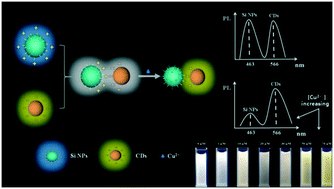A dual-emission ratiometric fluorescent nanoprobe based on silicon nanoparticles and carbon dots for efficient detection of Cu(ii)†
Abstract
In this work, a new type of ratiometric fluorescent nanoprobe with dual-emission properties is designed and constructed. The dual-emission nanoprobe is prepared from fluorescent silicon nanoparticles (Si NPs) and carbon dots (CDs). The surface of the silicon nanoparticles is positively charged while that of the carbon dots is negatively charged. Thus, the silicon nanoparticles and the carbon dots can be combined by electrostatic interactions to form a dual-emission nanoprobe. The blue-emitting silicon nanoparticles and yellow-emitting carbon dots with similar excitation wavelengths can emit the dual emission peaks under a single excitation. As a result, we obtained a novel dual-emission Si NP–CD nanoprobe. The PL intensities of our nanoprobe exhibit a high PL quenching efficiency for sensitive and selective detection of Cu2+. Upon exposure to Cu2+, the blue emission from the Si NPs is quenched, while the yellow emission from the CDs remained stable. Meanwhile, the PL color of the nanoprobe changed from white to yellow, which realized the PL and visual detection of Cu2+. The limit of detection can reach as low as 10 nM, which indicates that our dual-emission nanoprobe is an excellent PL and visual nanoprobe for environmental monitoring, chemical analysis, medical diagnosis, and food safety detection.

- This article is part of the themed collection: Nanomaterials


 Please wait while we load your content...
Please wait while we load your content...